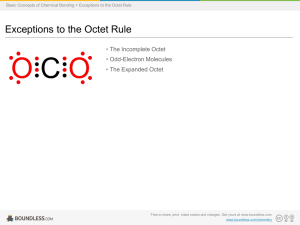Exceptions to the Octet Rule Hybridization
advertisement
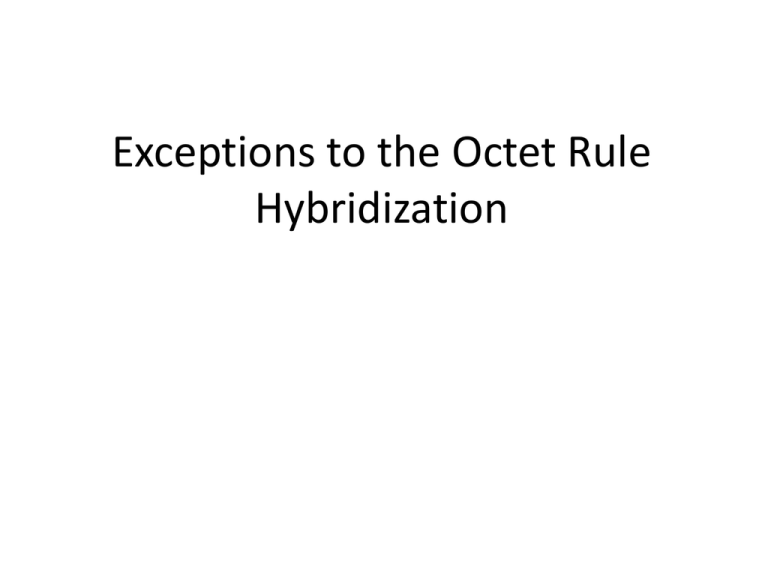
Exceptions to the Octet Rule Hybridization Objective Today I will be able to: Determine the exceptions to the octet rule Predict the molecular shape of a molecule using the VSEPR theory Apply hybridization to determining the orbital shape of a molecule Evaluation/ Assessment Informal assessment – Listening to group interactions as they complete the exeptions to the octet Lewis Structure Practice Formal Assessment – Analyzing student responses to the exit ticket and the Lewis Structure Practice. Common Core Connection Make sense of problem and persevere in solving them Reason abstractly and quantitatively Use appropriate tools strategically Look for and make use of structure Lesson Sequence • • Warm – Up Evaluate: Bonding and Nomenclature Exam Part 1 – Formal Assessment • • Explain: Molecular Polarity Elaborate: Molecular Shapes Lab Polarity – Formal and informal assessment • • Engage: Holiday Activity Evaluate: Exit Ticket • Formal assessment Warm - Up • What molecular shapes allow for a molecule to have an expanded octet? • Draw the Lewis Structure for BF3 – What is its molecular shape? – What angles are present in the shape? – Polar or nonpolar? Objective • Today I will be able to: – Predict the molecular shape of a molecule using the VSEPR theory – Predict the molecular shape of a molecule using the VSEPR theory – Apply hybridization to determining the orbital shape Homework • STEM Fair Presentations – January 23 • Finish VSEPR Theory Practice Agenda • • • • • • Warm – Up Pass out course recommendation slips Exceptions to the Octet Rule notes VSEPR Theory Practice Hybridization Exit Ticket Exceptions to the Octet Rule Notes Exceptions to the Octet Rule • Molecules with an odd number of valence electrons – Example: NO Exceptions to the Octet Rule • Free Radical – unpaired electrons • Occurs in molecules with an odd number of electrons • Typical causes of free radicals - increased oxygen (take in ozone) - smoking - UV light Exceptions to the Octet Rule • Free Radicals (continued) • Can damage cells, and cause advanced aging • Antioxidants bind with free radicals, making them significantly less harmful Exceptions to the Octet Rule • Less than an Octet Exceptions to the Octet Rule • BF3 commonly bonds with NH3 Exceptions to the Octet Rule • More than 8 valence electrons • Occur in atoms that have the 3d sublevel available for bonding Exceptions to the Octet Rule • Atoms that only have two valence electrons • H, He, Li, and Be • Stable with only two valence electrons in their s sublevel VSEPR Theory Practice Work with the people in your row. We will review the answers as a class Draw the Lewis Structures for the following molecules • • • • • Determine the shape CH3Cl CH2O BCl3 PF5 • • • • SF6 XeF4 SF4 ICl3 Hybridization Hybridization What is hybridization? • Atoms use their valence electrons to form bonds. But how is it that they form bonds of equal energy when some of the electrons come from the s orbital and some come from the p orbital?? • Hybrid orbitals are orbitals of equal energy (between the energy of s & p orbitals) produced by the combination of two or more orbitals on the same atom. Hybridization • An atom in a molecule may adopt a different set of atomic orbitals (called hybrid orbitals) than those it has in the free state. • See B&L pages 319-322 for explanation and diagrams of electron promotion • The hybridization of a particular molecule is determined by the central atom. • We only need to worry about it’s valence electrons. Your Hybridization Options: • • • • • • sp sp2 sp3 sp3d sp3d2 sp3d3 Hybridization BeF2 Look at B Write the orbital diagram for B You need to have 2 e- available to bond to F Write a new orbital diagram Promote electrons BeF2 http://wps.prenhall.com/wps/media/objects/3081/3155729/blb0905/bl09p312b.jpg Hybridization BCl3 Look at B Write the orbital diagram for B Promote electrons Exit Ticket • Determine the shape of the following molecules – XeF4 – PCl5 – NH3 http://www.dlt.ncssm.edu/tiger/diagrams/moleculargeometry/BCl3_Hybrid.gif Consider CH4 Carbon has 4 valence electrons 1s2 2s2 2p2 2 of the electrons are in the s orbital and 2 are in the p orbital. s & p have different shapes and different amounts of energy. Consider CH4 To create 4 equal bonds, carbon’s one 2s and three 2p orbitals fuse into 4 new identical orbitals called sp3. 2p Hybridization sp3 2s • What type of hybridization does BF3 have? • 1s2 2s2 2p1 Empty hybridized orbitals are dropped 2p Hybridization sp3 2s sp2 So sp3 becomes sp2 How do you include lone pairs of ein hybridization? • Each lone pair of electrons has it’s own hybridized orbital. • See next slide. What type of hybridization does H2O have? Oxygen e- configuration 1s2 2s2 2p4 (Use oxygen because it is the central atom) 2p Hybridization sp3 2s • Draw the hybridization orbital diagram for phosphorus in PCl3 Try this hybridization animation http://www.mhhe.com/physsci/chemistry/essen tialchemistry/flash/hybrv18.swf
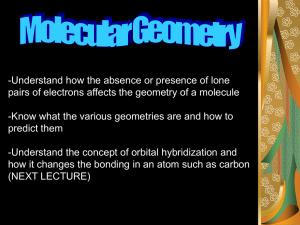
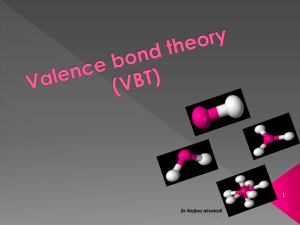
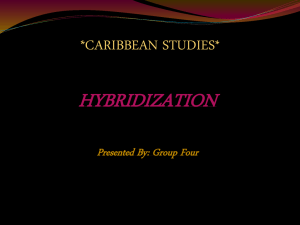



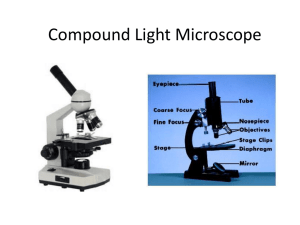
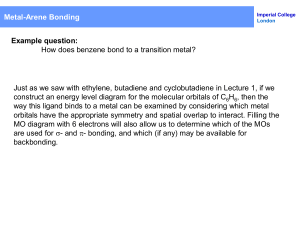

![Intro to Semiconductors and Diodes []](http://s2.studylib.net/store/data/005340797_1-9cc5e13687b40f30b11ab4990fa74479-300x300.png)
